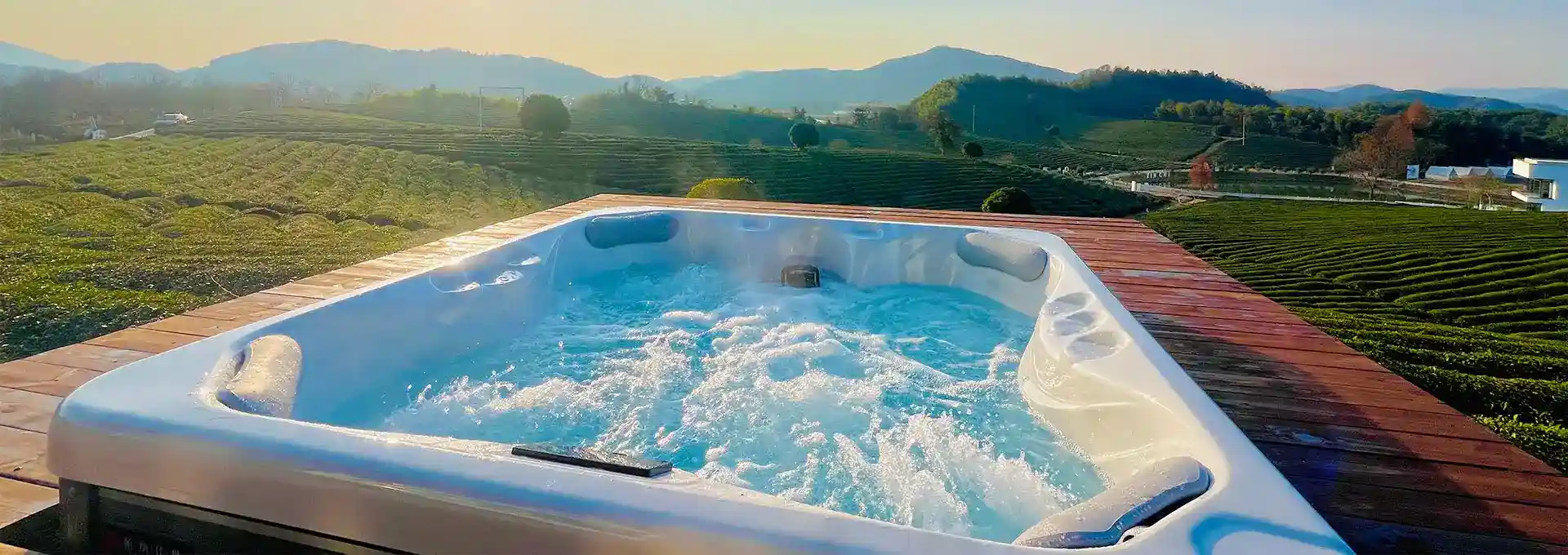Can a Frozen Hot Tub Be Repaired?
2024-10-23 17:55:24
As winter's icy grip tightens, many hot tub owners face a chilling question: can a frozen hot tub be repaired? The short answer is yes, but the process can be complex and potentially costly. When water freezes, it expands, potentially causing significant damage to your hot tub's pipes, pump, and other critical components. However, with proper care and swift action, a frozen hot tub can often be salvaged. This blog post will explore the intricacies of dealing with a frozen hot tub and provide valuable insights on winter hot tub maintenance to prevent such issues in the first place.
How do you winterize an outdoor hot tub?
Winterizing your outdoor hot tub is a crucial step in protecting your investment from the harsh effects of cold weather. Proper winterization can prevent freezing, damage, and costly repairs. Here's a comprehensive guide to winterizing your outdoor hot tub:
1. Drain the Water: The first step in winterizing your hot tub is to completely drain all the water. This includes not only the main tub but also any pipes, pumps, and filters. Use a submersible pump to remove most of the water, then open all drain plugs to ensure every drop is out.
2. Clean and Dry: Once drained, thoroughly clean the tub's surface with a non-abrasive cleaner. Pay special attention to the shell, jets, and any crevices where water might collect. After cleaning, use a wet-dry vacuum to remove any remaining water from the jets and plumbing lines.
3. Remove and Clean Filters: Take out all filters, clean them thoroughly, and store them in a dry place. This prevents mold and mildew growth during the off-season.
4. Blow Out the Lines: Use a shop vac or a specialized hot tub blower to force any remaining water out of the plumbing lines. This step is crucial as any water left in the lines can freeze and cause significant damage.
5. Add Antifreeze: If you live in an area with extremely cold winters, consider adding non-toxic antifreeze to the plumbing lines for extra protection. Always use antifreeze specifically designed for hot tubs.
6. Disconnect the Power: Turn off the power to the hot tub at the circuit breaker. This prevents any accidental start-ups during the winter months, which could damage the system if it's not properly filled with water.
7. Clean and Treat the Cover: Thoroughly clean the hot tub cover and treat it with a vinyl protectant. This helps prevent cracking and extends the life of your cover.
By following these steps, you can significantly reduce the risk of freeze damage and ensure your hot tub is ready for use when warmer weather returns. However, if you plan to use your hot tub during winter, different precautions are necessary.
What temperature should I keep my outdoor hot tub in winter?
Maintaining the right temperature in your outdoor hot tub during winter is crucial for both enjoyment and protection of your investment. The ideal temperature depends on various factors, including your personal preference, energy efficiency considerations, and the climate in your area. Here's a comprehensive guide to help you determine the optimal temperature for your outdoor hot tub in winter:
1. Standard Operating Temperature: Most hot tub manufacturers recommend keeping the water temperature between 100°F and 104°F (37.8°C to 40°C) for adult use. This range provides a comfortable soaking experience while being safe for most healthy adults.
2. Energy Efficiency Considerations: In winter, maintaining a high temperature can significantly increase energy costs. To balance comfort and efficiency, consider keeping your hot tub at the lower end of the recommended range, around 100°F to 102°F (37.8°C to 38.9°C).
3. Usage Frequency: If you use your hot tub frequently, maintaining a consistent temperature is more energy-efficient than repeatedly heating it from a lower temperature. However, if you only use it occasionally, you might consider lowering the temperature slightly between uses.
4. Climate Factors: In regions with extremely cold winters, you may need to keep the temperature slightly higher to prevent freezing. In such cases, aim for 102°F to 104°F (38.9°C to 40°C).
5. Safety Considerations: Never let your hot tub temperature exceed 104°F (40°C). Higher temperatures can lead to overheating, dehydration, and other health risks, especially in winter when the contrast with the outside temperature is more extreme.
6. Freeze Protection Settings: Most modern hot tubs have a freeze protection mode that automatically activates the heater and circulation pump when the water temperature drops below a certain point (usually around 44°F or 6.7°C). Ensure this feature is enabled for added protection against freezing.
7. Cover Usage: Always use a well-insulated cover when the hot tub is not in use. This can significantly reduce heat loss and maintain a more consistent temperature, reducing the energy needed to reheat the water.
Remember, while it's important to prevent freezing, running your hot tub at excessively high temperatures in winter can lead to increased energy costs and potential safety risks. Regular maintenance, including checking the water chemistry and ensuring proper filtration, becomes even more critical in winter to keep your hot tub running efficiently and safely.
How much does it cost to run an outdoor hot tub in winter?
The cost of running an outdoor hot tub in winter can vary significantly based on several factors, including the size of the tub, local energy prices, climate conditions, and how efficiently you manage your hot tub. Understanding these costs can help you budget appropriately and implement strategies to minimize expenses without sacrificing enjoyment. Let's break down the various factors that contribute to the cost of running an outdoor hot tub in winter:
1. Energy Consumption: The primary cost associated with running a hot tub in winter is electricity. Hot tubs typically use between 1,500 to 6,000 watts of power, depending on their size and features. In winter, the heater works harder to maintain temperature, increasing energy consumption.
2. Electricity Rates: The cost of electricity varies by location and provider. On average, electricity rates in the United States range from $0.10 to $0.20 per kilowatt-hour (kWh). To calculate your potential cost, multiply your hot tub's wattage by the hours of operation, then by your electricity rate.
3. Climate Impact: Colder climates require more energy to maintain water temperature. In regions with harsh winters, expect higher operating costs compared to milder climates.
4. Insulation Quality: Well-insulated hot tubs retain heat better, reducing energy costs. High-quality covers and additional insulation can significantly lower operating expenses.
5. Usage Patterns: Frequent use may actually reduce costs in some cases, as maintaining a constant temperature can be more efficient than repeatedly heating cold water.
6. Size of the Hot Tub: Larger hot tubs require more energy to heat and maintain temperature, leading to higher operating costs.
7. Temperature Settings: Higher temperature settings increase energy consumption. Lowering the temperature by just a few degrees when not in use can result in significant savings.
8. Maintenance Costs: Regular maintenance, including water treatment chemicals and filter replacements, adds to the overall cost. These costs may increase in winter due to more frequent use and harsher conditions.
To provide a rough estimate, running a mid-sized hot tub (350-400 gallons) in a moderate winter climate might cost between $50 to $120 per month in electricity. However, this can vary greatly based on the factors mentioned above.
To minimize costs:
- Use a high-quality, well-fitting cover to retain heat
- Invest in additional insulation for the cabinet and plumbing
- Lower the temperature when the hot tub is not in use
- Consider using a timer to run the filtration system during off-peak electricity hours
- Regularly maintain your hot tub to ensure it's operating at peak efficiency
- Use wind barriers or strategically place your hot tub to minimize heat loss
It's worth noting that while running a hot tub in winter does incur costs, many users find the therapeutic benefits and enjoyment outweigh the expenses. Additionally, having a warm retreat in your backyard can reduce the need for winter getaways, potentially saving money in the long run.
When considering the cost of running an outdoor hot tub in winter, it's essential to factor in the quality of the hot tub itself. This is where products from Shenzhen Iparnassus Intelligent Spas Co., LTD stand out. As a company specializing in vacation hot tubs and infinity pool spas, Iparnassus offers solutions that are particularly well-suited for year-round use, including in challenging winter conditions.
Iparnassus hot tubs are equipped with advanced circulation filtration and sterilization systems, which reduce the need for frequent water changes. This not only saves on water costs but also minimizes the energy required to heat new water, a significant factor in winter operating costs. The company's commitment to innovation is evident in their 30+ patents as of 2023, suggesting cutting-edge technology that likely includes energy-efficient features.
For hotels and resorts in cold climates, Iparnassus offers tailored solutions that can significantly reduce the cost of running multiple hot tubs in winter. Their offer of free mold customization and upgraded electronic controls with a centralized hotel management system can lead to more efficient operation and lower energy costs across multiple units. The direct partnership with top manufacturers allows for competitive pricing without compromising on quality, which is crucial for managing long-term operational costs.
While the initial investment in a high-quality hot tub from Iparnassus may be higher, the long-term savings in energy costs, especially in winter, can be substantial. Their products, which meet North American manufacturing standards, are designed for durability and efficiency, potentially reducing both running costs and the need for repairs or replacements.
In conclusion, while running an outdoor hot tub in winter does come with increased costs, careful management and investment in quality equipment can help minimize these expenses. Products from companies like Iparnassus, with their focus on efficiency and advanced technology, can play a significant role in making winter hot tub use both enjoyable and economically feasible.
For more information on hot tub installations and our products, please feel free to contact us at info@iparnassus.com.
References:
1. Energy.gov. (2023). Energy-Efficient Home Design.
2. Hot Tub Owner HQ. (2024). Hot Tub Winterization Guide.
3. Swim University. (2023). How to Winterize an Above Ground Pool.
4. Home Advisor. (2024). How Much Does a Hot Tub Cost to Run?
5. Spa Depot. (2023). Hot Tub Energy Consumption Guide.
6. POOLSEARCH. (2024). How to Winterize Your Hot Tub.
7. Hot Spring Spas. (2023). Hot Tub Temperature Guide.
8. Master Spas. (2024). Energy Efficient Hot Tubs: A Complete Guide.
9. Caldera Spas. (2023). How to Reduce Hot Tub Running Costs.
10. Bullfrog Spas. (2024). Hot Tub Maintenance in Cold Weather.



